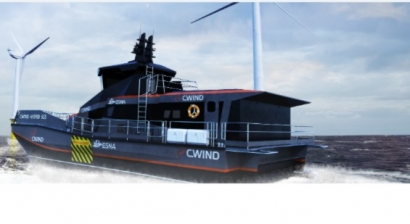
The agreement between Ørsted and CWind, part of the Global Marine Group, covers an initial three-year firm charter with options available for a further two years. The Hybrid SES crew transfer vessel will be operating from the Dutch port of Vlissingen, to Borssele 1 and 2, located 23km from the Dutch coast in the North Sea.
The development of the Hybrid SES for use as a crew transfer vessel is in response to an industry-wide push to develop and deploy innovative technologies that reduce CO2 emissions while cost effectively servicing wind farms located further offshore. CWind’s Hybrid SES crew transfer vessel achieves this through a combination of electric and diesel propulsion which, when combined with the surface effect hull form and heave compensation technology, is able to operate in sea states of up to 2.0m Hs, while decreasing fuel burn and CO2.
Ian Bryan, Managing Director, Group Business Operations said, “We are delighted to announce the agreement with Ørsted, and look forward to delivering the world’s first Hybrid SES for them in 2020.”
The Hybrid SES crew transfer vessel was developed in partnership with ESNA, a ship design company based in Kristiansand, Norway. ESNA specializes in surface effect vessel development to deliver commercially competitive vessels with significant carbon reductions by design.
The vessel will be built by Wight Shipyard Company, a leading UK boat builder. The Hybrid SES propulsion engine will deliver sprint speed and extreme bollard push, from its 1,300 kW installed diesel engines, which can be battery boosted up to 1,500 kW. Significant fuel savings are produced through balancing engine and inefficient low engine power running hours, with battery drive modes including wind farm standby and low speed/harbor operations. This leads to engine operating hours being reduced by 50% during wind farm battery standby.

